Children today are more stressed and anxious than ever. With all the changes, conflicts, and uncertainty in the world right now, taking care of our kids’ mental health should be on the top of our priority list. One of the easiest ways to help calm anxiety (in both kids and adults) is by spending time outside in nature. The healing power of nature is immense and the benefits of the outdoors are incredible for physical and mental health. Today, Tiffany Griffin (Texas homeschooling mom and photographer) is here to discuss one easy way to help kids connect to the earth with grounding. She explains what grounding is, what the benefits are, and ways your kids can recharge and reap the benefits of mother nature.
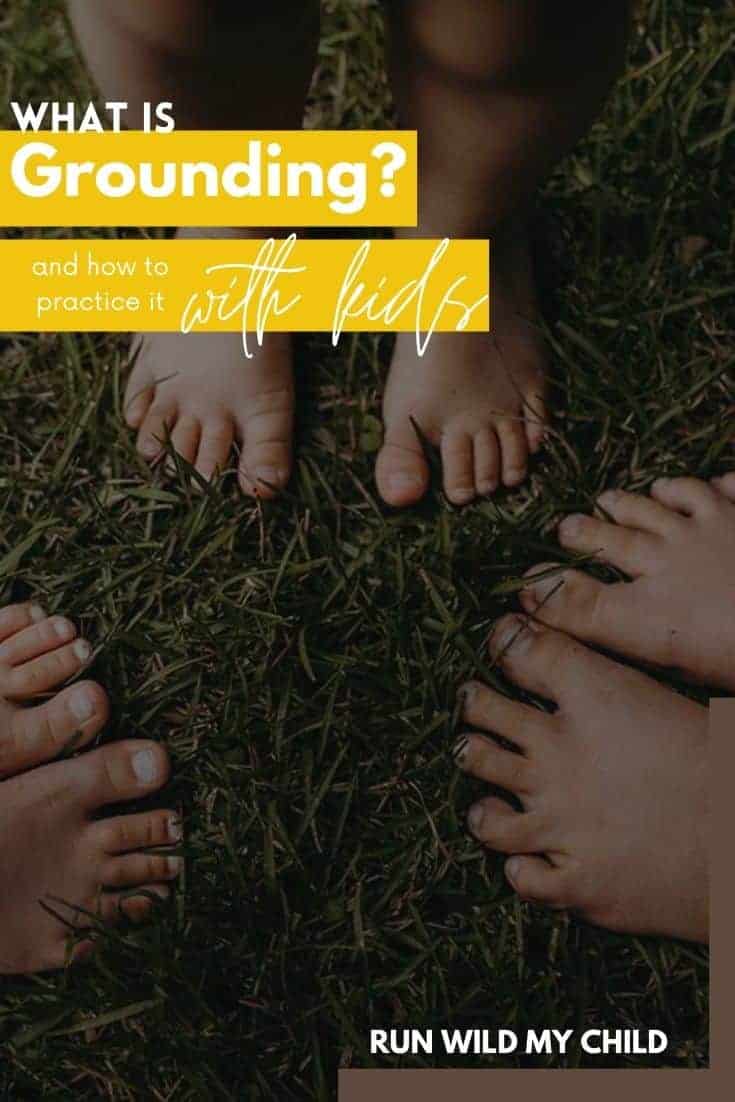
Connecting with nature
Do you know that feeling when looking at a beautiful mountain ridge? Or the way your mind eases when you hear the soft rippling flow of stream? That is Mother Nature doing her best work. Just the experience of being in and surrounded by nature is healing. Research has shown (and mental health professionals agree) that spending time in green (and blue) spaces is good for the mind, body, and soul.
Now, imagine what that would do for you and your children if you were to physically connect yourself to the earth outside of your visual experience. Instead of just being in nature, you’re touching it as a full sensory experience. That’s what grounding (earthing) is all about.
The ground we walk on is full of positively charged ions, just waiting to realign your electrical energy. The Earth is like a gigantic battery that contains a natural, subtle electrical charge. Our entire world is beautifully electrical, and we are electrical beings made of atoms living amongst a plethora of other electrical beings! Everything on this planet is made of atoms, meaning everything has a positive, negative, or neutral charge. For safety and stability, almost everything in the electrical world is connected to the earth and its charge.
Unfortunately, when your body’s overall charge is off, chemical reactions happen that shouldn’t. We are – in short, a variety of chemical reactions. Think of yourself as a LONG-lasting battery. You can keep going, but you NEED a recharge every now and then. Mother Nature has the ultimate remedy for you when you’re feeling off or need recharging. Enter – grounding.
For additional information on electrical charges and free radicals, check out this post from The Earthing Institute.
 Photo credit: @kristcx
Photo credit: @kristcx
What is grounding?
When your body is in direct contact with the earth, without any disruption, like shoes or carpet – that is grounding. Earthing is the intentional practice of allowing your bare skin to be in contact with the earth. Earthing happens when you walk on the ground with bare feet, touch a tree, or lie in the grass.
The act of grounding (also called earthing) is a therapeutic technique that involves doing activities that “ground” or electrically reconnect you to the earth. This means that when you physically touch the ground, electrical charges are transferred from the earth to you, positively affecting your body. The energy from the earth nurtures and balances your body at the deepest levels, decreasing inflammation, pain, stress, and fatigue.
This is true for children as well! Children can practice earthing by just touching the earth as much as possible. Building sand castles, making tree forts, helping in the garden, swimming in the lake or ocean are all ways kids can be exposed to the earth’s healing energy. Sitting or walking on the concrete is another way to connect to the ground as concrete is moist and conductive. The more extensive and longer periods of time children spend touching the earth, the greater the benefits, which in turn encourages self-regulation and releases negative feelings.
In simple terms – go outside, take your shoes off, and make direct contact! It’s good for you and the best way to “ground.”

Benefits of grounding for kids
People all over the world in diverse cultures have talked about the benefits of grounding (earthing) and how to improve their health and well-being from being barefoot on the earth for thousands of years. Although this may seem new to some, it is really prevalent in other cultures and has been around for centuries.
When you are grounded to the earth, you feel centered, strong, solid, balanced, stable, less tense, and less stressed. Grounding has been shown to reduce inflammation, improve emotional regulation, and decrease pain. It’s been connected with improving heart rate, stress levels, sleep, healing, and immunity.
While grounding does wonders for an adult, imagine how important this practice is for our generation of children? These days, just the act of relying on the earth for any form of healing feels like an act of rebellion. If you’re reading this and thinking it’s way too “woo woo” and granola for you, you’re not alone! It does sound a bit crazy. But trust me and hear me out.
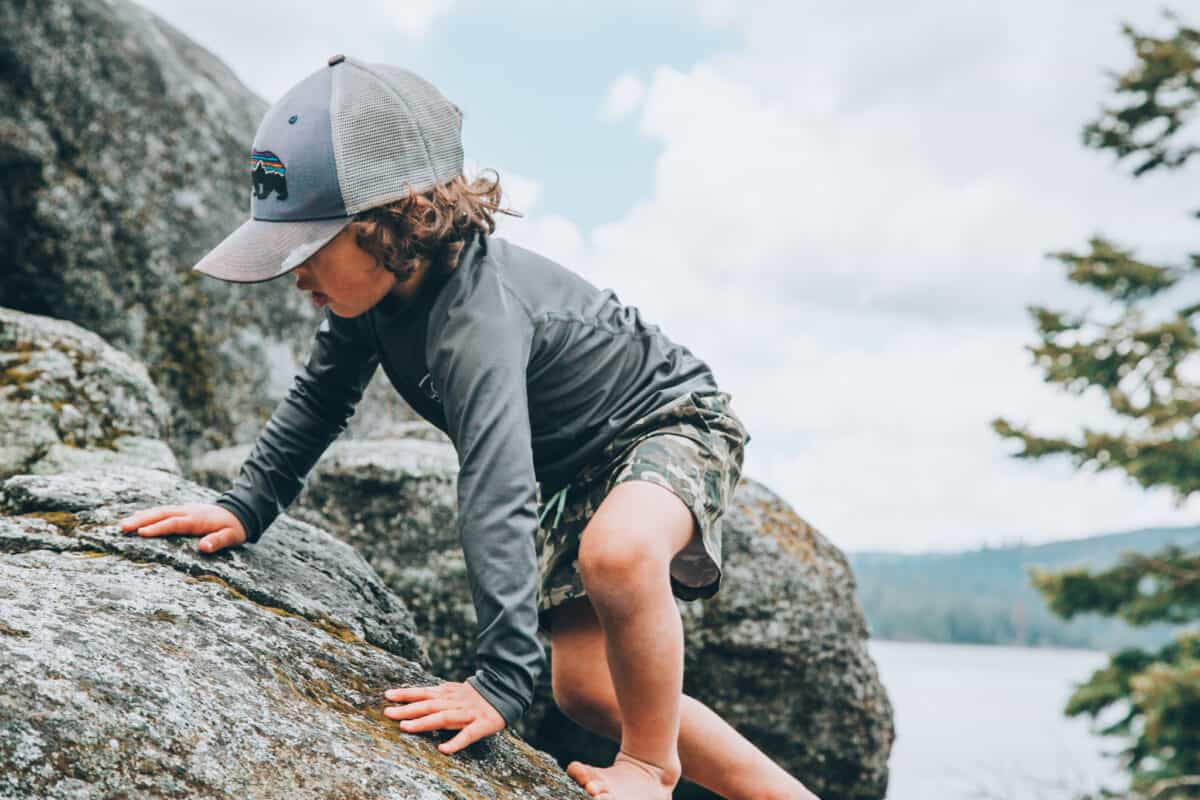 Photo credit: @roaminggonzalez
Photo credit: @roaminggonzalez
Connection to the earth
Far fewer things can provide to our mind, body, and soul what mother nature can in her raw form. We know just being outside is good for us – it provides us with vitamin D, which triggers an anti-microbial response. It helps us relax, makes us more creative, and decreases stress levels.
Connecting physically with the Earth takes that a step farther, providing even more amazing benefits. Allowing your children to be exposed to dirt exposes them to a variety of bacteria and microorganisms that boost the immune system, reduce allergies, and works as an all-natural anti-depressant and stress management. Earthing helps you to sleep better, lessens anxiety and depression, helps your body heal, reduces inflammation and blood pressure, relieves muscle and joint pain, increases energy while promoting calmness, and enhances overall health.
Not only is grounding/earthing beneficial, but it is also crucial for raising healthy and mentally strong children. How amazing is it that we can turn an entire day around by just placing our feet on the earth!?
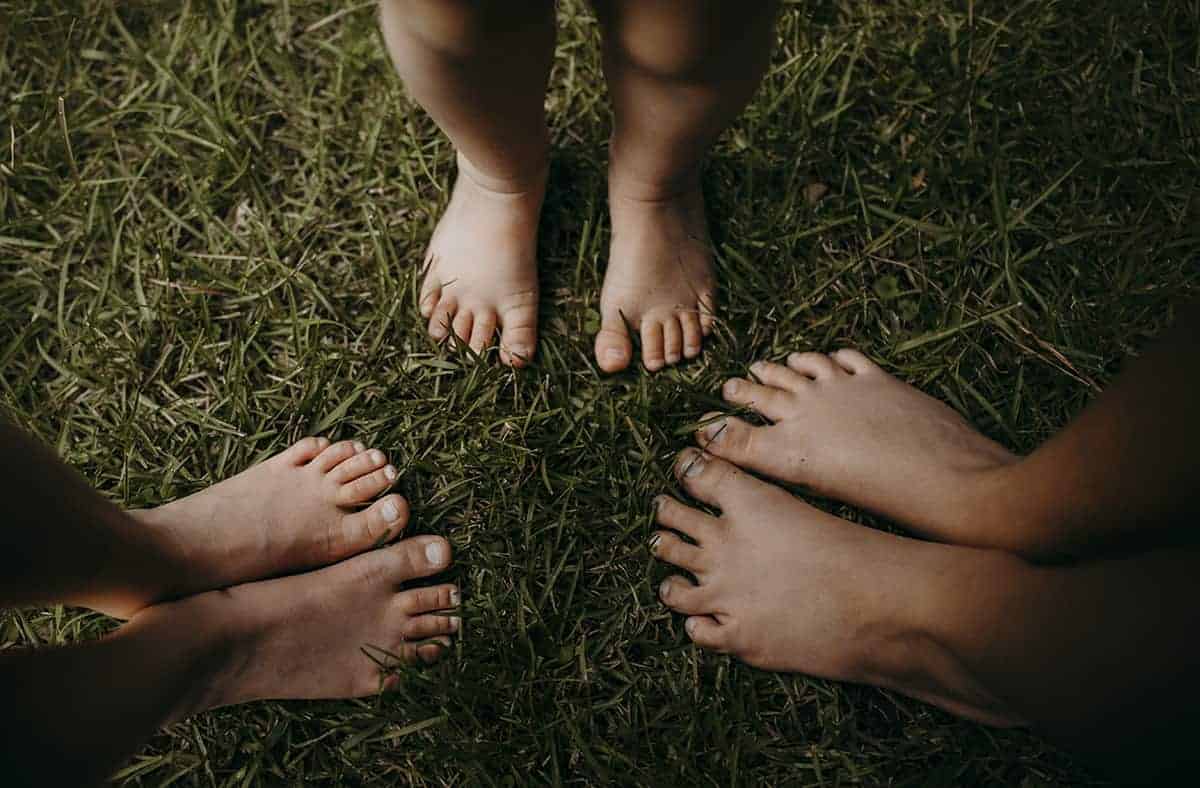
Grounding ideas for kids
Incorporating earthing into your child’s routine can be a delightful and enriching experience. Now that you know why grounding is so important and what it can do for you, here are a few ways you can experience the benefits of grounding and earthing with your children. Here are some practical and creative grounding exercises, grounding activities and grounding techniques to help your kids connect with the Earth and reap the benefits of grounding:
1. Barefoot nature walk
The easiest way to experience grounding is to get outside barefoot! Our feet have a high amount of nerve endings which are needed for electron transfer to occur. You could spend as little as 10 minutes outside and see some benefits. Take your shoes and socks off and place your feet directly on the ground. Walk together barefoot outside on dry or wet grass and/or dirt! Even concrete or brick is a conductor and can transfer energy and electrons.
Hold hands with your child, take a moment from the real world and just enjoy the conversation! Ask them to pay attention to the feeling of different surfaces under their feet – the softness of grass, the roughness of a dirt path, the cool, uneven surface of pebbles, etc. This sensory exploration can be a great learning experience. This is a wonderful way to connect with your child (and the earth) and a great stress relief for you both. Mud is even better – embrace the mess! Tap into your inner child and just DO IT!
2. Hug a tree
Show Mother Nature some love by hugging your favorite tree (any tree will do!). Firm pressure is an excellent way for kids to feel more stable and grounded. Lots of therapies have kids hug themselves, but hugging a tree works great for this, as it gives kids the pressure they crave, combined with the connection to nature.
Feel the texture and smell the bark. Put your cheek on the tree and take it all in! Give it a big hard squeeze and feel the pressure points and all the contact. Hugging a tree can increase your levels of the hormone oxytocin. This hormone is responsible for feeling calm and emotional bonding.
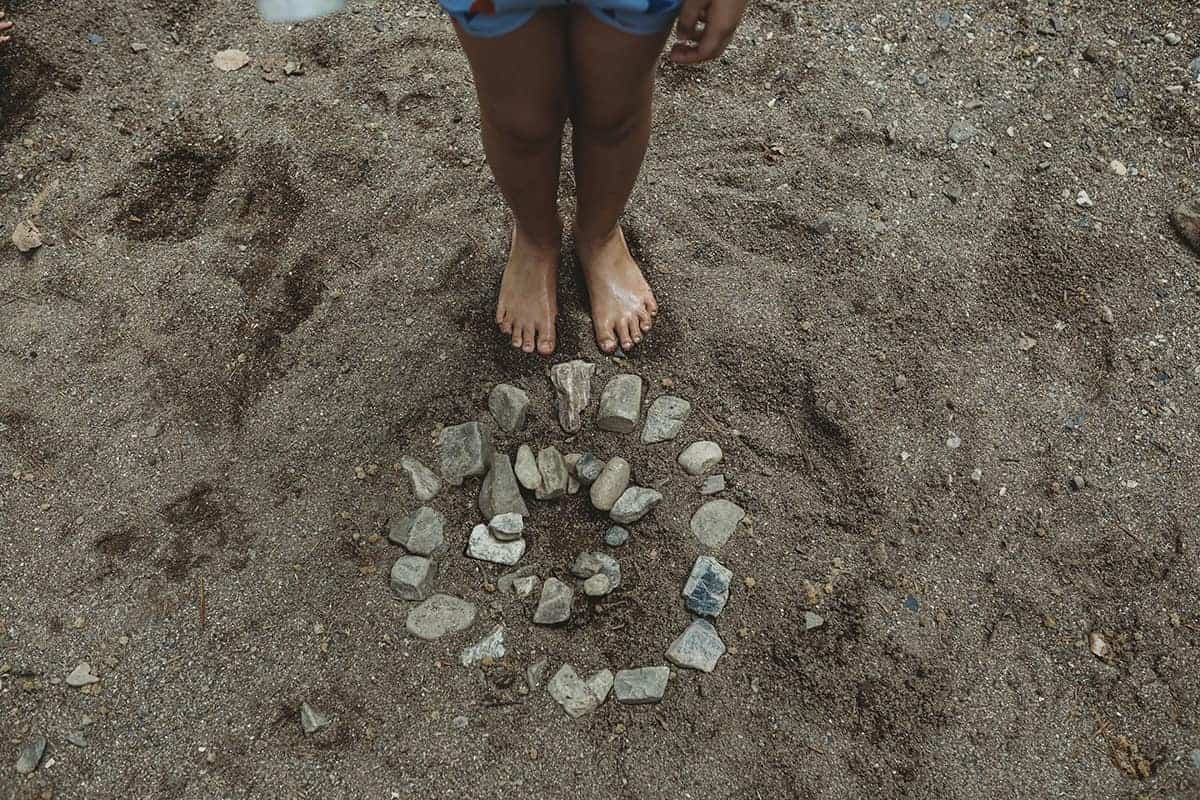
3. Feet in the sand or submerge in water
If you’re lucky enough to live near the beach or body of water – enjoy it! Wet sand is the best conductor of energy from the earth. Ever wonder why the coasts always have some major vibes…Mother Nature knows what she’s doing!
The Blue Mind theory, popularized by marine biologist and neuroscientist Wallace J. Nichols, Ph.D., is the mildly meditative state people fall into when they are near, in, under, or on water. This theory posits that spending time near or around water (be it oceans, lakes, or rivers), triggers a neurological and psychological response that promotes relaxation, reduces stress, and enhances overall well-being. By immersing ourselves in the sights and sounds of blue spaces, we tap into a deep-seated connection with water that calms our mental state, encourages creativity, inspires reflection, and fosters a sense of interconnectedness with the natural world.
(Be sure to read our full post on the benefits of spending time in Blue Spaces.)
Some grounding advocates believe that water may be used to ground in the same way the physical earth is used for grounding. They suggest simply wading in a clear lake, walking through a creek, or swimming in the ocean as a way to ground yourself. As always, be sure to stay safe when swimming, especially in murky or deep waters, supervise children, and use flotation devices.

4. Sit spot
The idea of sit spotting is simple: find a special place in nature and then become comfortable with just being there, still and quiet. In this place, nature will surround you, soothe you, entertain you, and seep into you. Sit spotting gives you a personal and intimate place in nature which will soothe, comfort and relax you, as you get to know the location.
Your special place could be anywhere outside – at a local park or even in your back yard. Visit that place together often with your kids and talk about the world around you and how things have changed since your last visit. Sitting on a blanket is fine, but on the bare ground is best. Take your shoes off and explore.
You will notice quickly that our world is MUCH bigger than it seems. Talk about the plants, trees, animals, and bugs around you! Talk about the way your body feels in the present moment (and does it change as you sit there?). Incorporate a breathing exercise into your sit spot by doing some deep breathing and taking in your surroundings. This is especially helpful for children with sensory difficulties. This is also my favorite grounding activity for those hard days when the world feels extra heavy. If your child having an off day, take them to a “sit spot!”
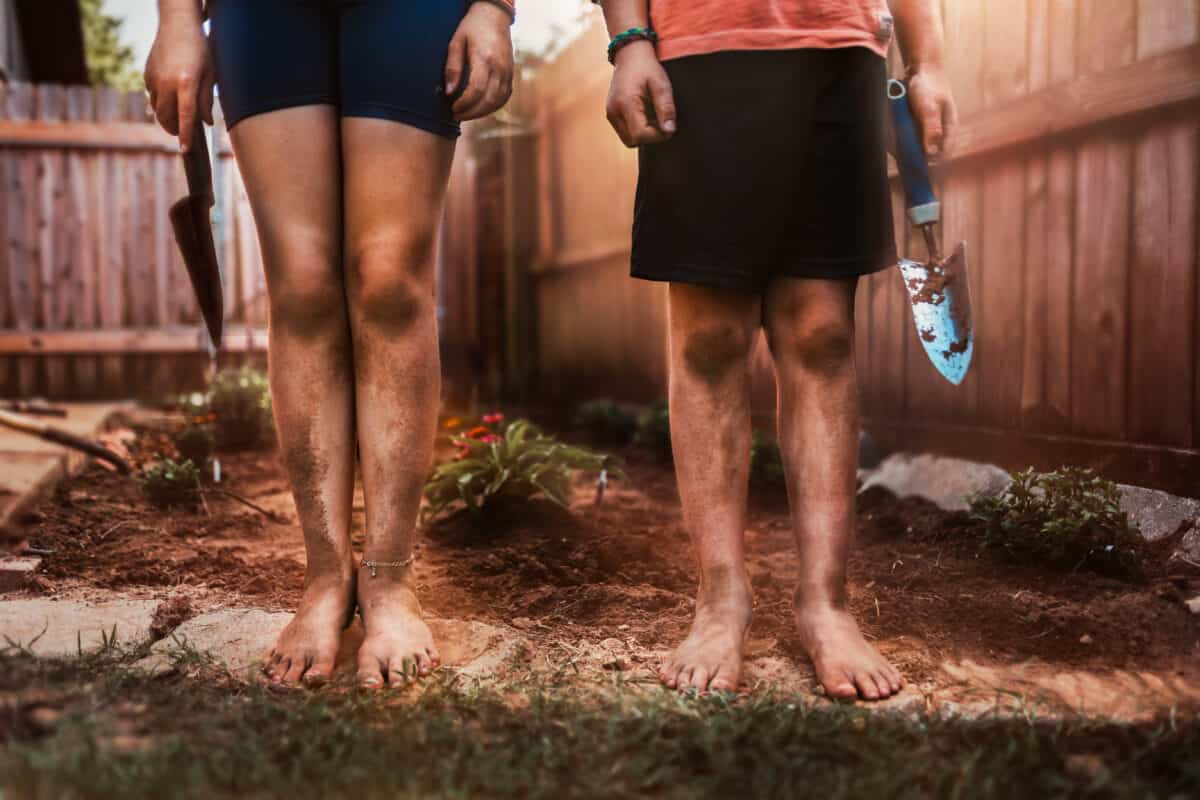 Photo credit: @kristcx
Photo credit: @kristcx
5. Gardening
Gardening provides an opportunity for children to practice of earthing while engaging in a hands-on learning experience. As kids dig their hands into the soil, they connect with the earth physically and develop a deeper understanding of the natural world around them.
Gardening allows children to witness firsthand the magic of plant growth, from seed to harvest, instilling in them a sense of wonder and appreciation for the interconnectedness of all living things. Moreover, as they interact with various plants and insects in the garden, children learn valuable lessons about biodiversity, ecosystem dynamics, and the importance of respecting and nurturing the environment.
By tending a garden, kids learn responsibility, patience, and perseverance as they observe the gradual progress of their plants and take on tasks like watering, weeding, and harvesting. Gardening also encourages creativity and problem-solving skills. Gardening is a great tool that helps kids develop a sense of pride and accomplishment in contributing to the creation of a beautiful and thriving garden space while deepening their connection to the earth and all its wonders.
For more information on this topic, be sure to check out our Ultimate Guide to Gardening with Kids.
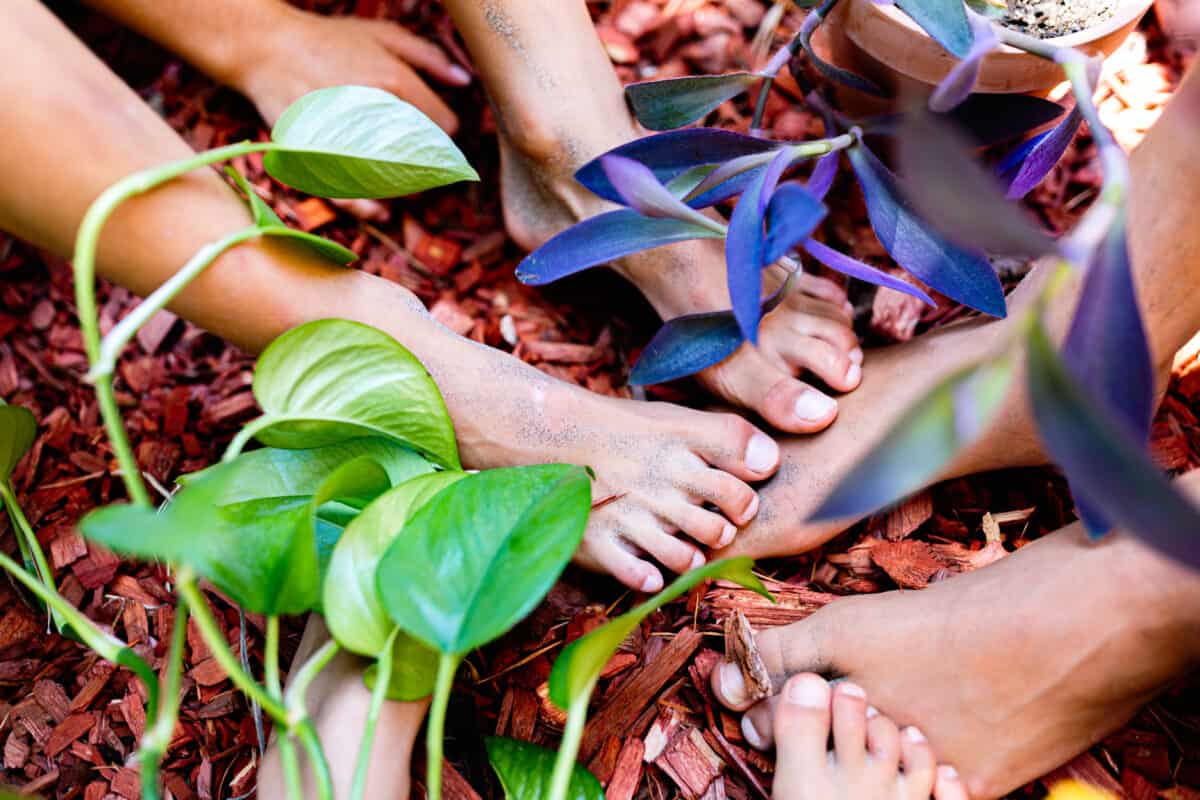 Photo credit: @wendycoxphotography
Photo credit: @wendycoxphotography
6. 5-4-3-2-1 game
While different strategies work for different kids, this grounding exercise is super simple and can be done by kids of all ages, nearly anywhere. All they need to do is pay attention to their senses and the environment around them. The 5-4-3-2-1 grounding technique is effective because it helps children focus on something tangible using their senses. It helps the mind focus, slowing down any racing thoughts or strong emotions that may be contributing to feelings of anxiety.
Here’s how to do it. When you’re outside in nature, have your child identify the following:
- five things they can see
- four things they can hear
- three things they can smell
- two things they can touch,
- one thing they can taste
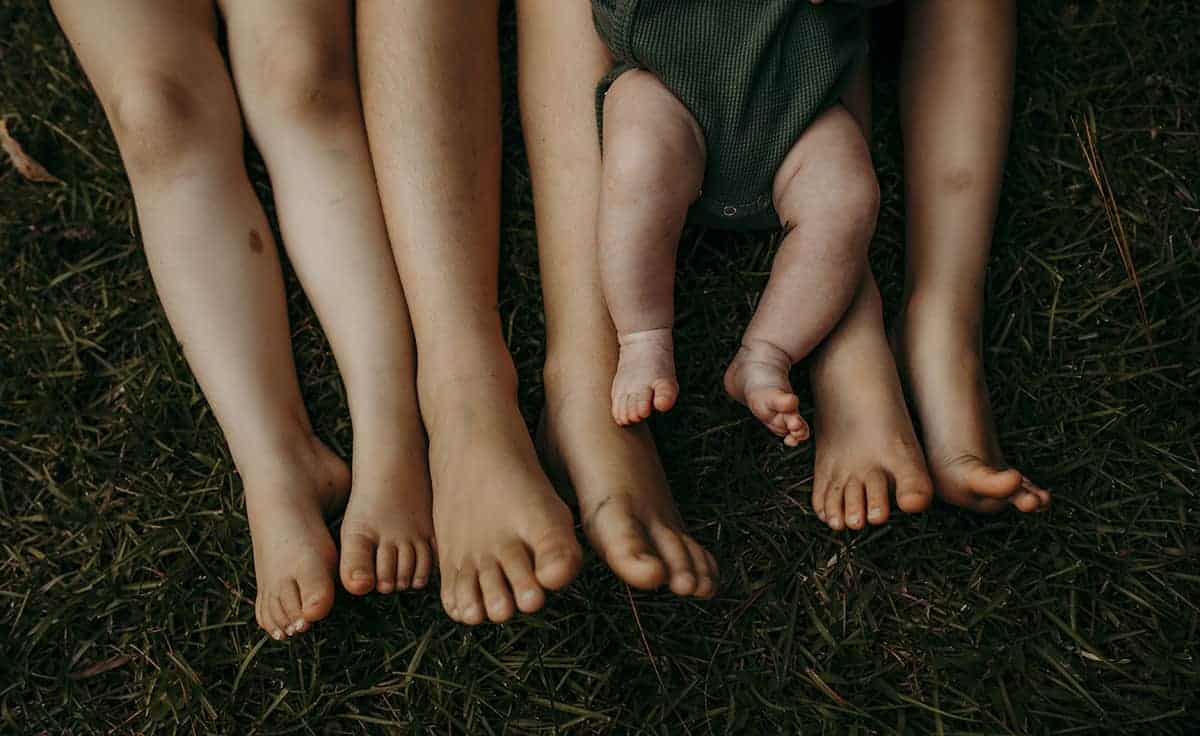
Battling the excuses
Weather (hot and cold), and hazardous or unsanitary surfaces keep many people from grounding and experiencing the power of being barefoot outside. Let’s get over those excuses and how to overcome them. Here’s some practical information on how to handle each of these excuses so that you can get outside and experience the benefits of grounding.
Weather
I know many parents who will use the weather as an excuse not to ground themselves. And weather conditions such as extreme heat or cold can present challenges for children to play outside barefoot. However, with proper preparation and awareness, mitigating these concerns and enjoying outdoor barefoot play is possible.
During the summer months children often have more opportunity to practice earthing or grounding as they spend a greater amount of time outside barefoot. During hot weather, we schedule outdoor playtime during cooler parts of the day, such as early mornings or evenings, to avoid the peak heat hours. Additionally, we seek shaded areas, wet areas (such as creeks), or grassy spots, which tend to be cooler than pavement or concrete surfaces. Stay vigilant for signs of discomfort or overheating, and encourage your children to stay hydrated by drinking plenty of water (popsicles also help).
On the other hand, during cold weather, time outside barefoot should be closely monitored by parents. Don’t worry, we’re not asking you to play outside in the snow barefoot! But, if it’s reasonable outside, then wearing warm layers will help protect against chilly temperatures, while still allowing for some barefoot exploration. Emphasize the importance of monitoring children for signs of discomfort or frostbite and encouraging regular breaks indoors to warm up.
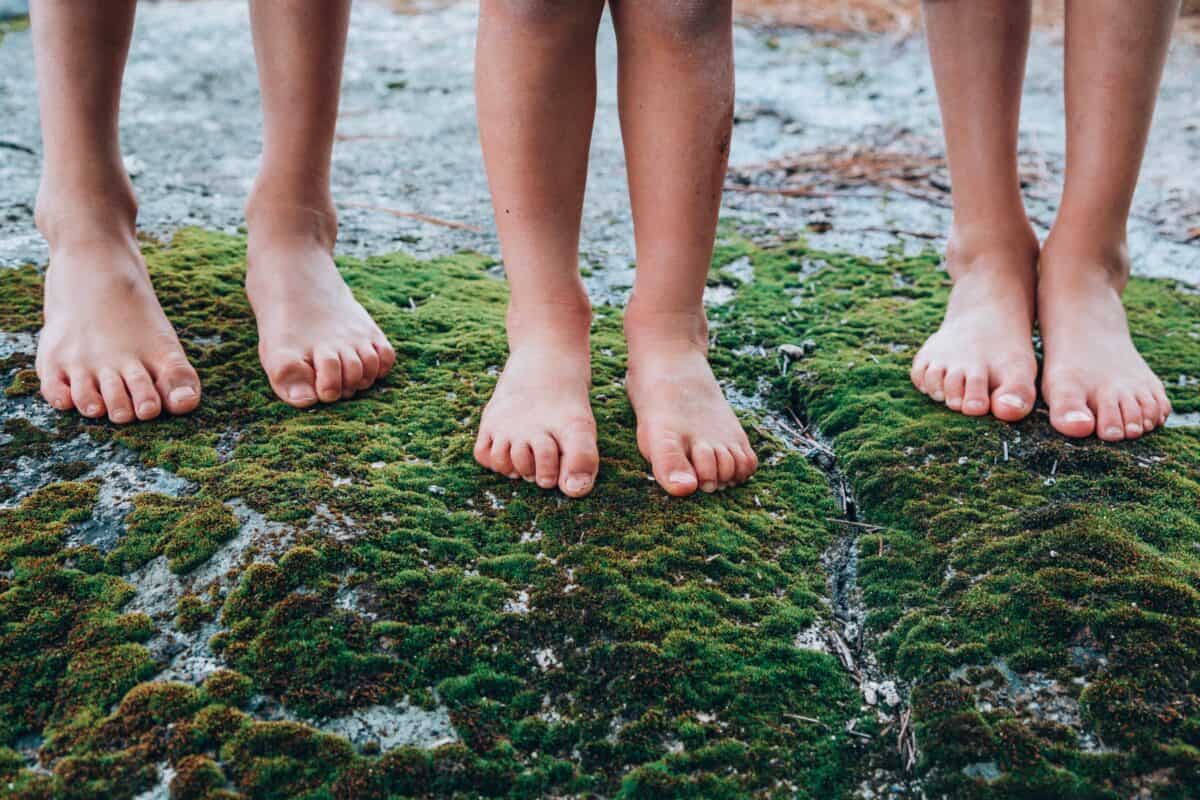 Photo credit: @roaminggonzalez
Photo credit: @roaminggonzalez
Unsafe surfaces
Lots of parents I know often express concerns about hazardous or unsanitary surface conditions when it comes to letting their kids play outside barefoot. Many parents are worried about their child stepping on broken glass at the park, or sharp rocks in the creek. Some parents are just opposed to their kids feet getting muddy, dirty, and “gross.”
However, while it’s essential to be mindful of potential risks, it’s also crucial to recognize the benefits of grounding for children’s well-being. Scout out safe areas for barefoot play. Look for grassy patches, sandy beaches, or well-maintained playgrounds where the risk of injury or exposure to harmful substances is minimized. Encourage you kids to ground in your own backyard.
Regularly check your child’s feet for any signs of injury or infection. If your child has a cut or open wound on their foot, it’s best to avoid earthing until it heals to prevent any risk of infection. Some children may have allergies to certain plants or grasses, so observe your child for any allergic reactions during their first few earthing experiences. Always supervise younger children during earthing activities. This not only ensures their physical safety but also allows you to guide and educate them about the process and its benefits.
Additionally, encourage children to inspect their surroundings and avoid areas with broken glass, sharp objects, or animal waste. Teaching them to be aware of their environment fosters a sense of responsibility and helps them make informed decisions about where to play barefoot safely.
By taking these precautions, earthing can be a safe, enjoyable, and beneficial activity for children. Remember, earthing is supposed to enhance our children’s well-being, so safety should always be the primary concern.
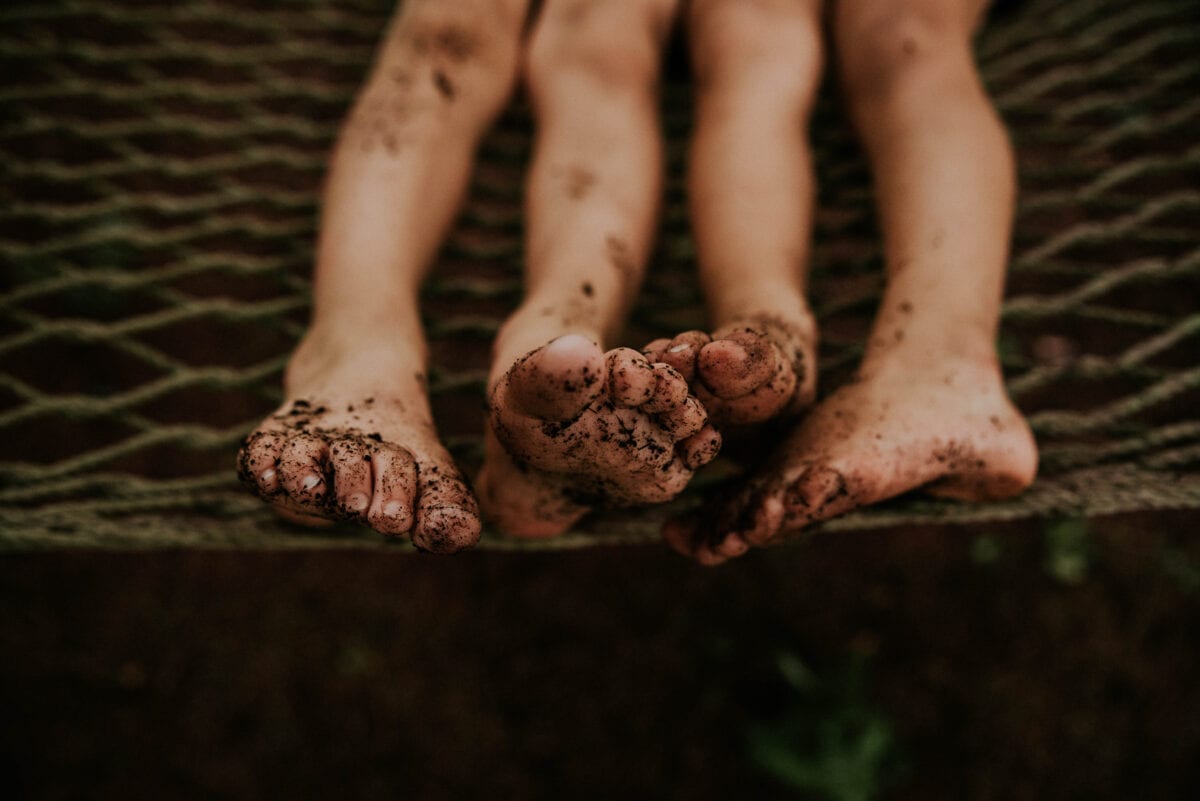 Photo credit: @motherhenshomestead
Photo credit: @motherhenshomestead
Overcoming Nature Deficit Disorder
There is much to say about kids spending too much time indoors. This issue has become so extreme that the crisis has a name: Nature deficit disorder. Many studies have shown that kids who play outside are smarter, happier, more attentive, and less stressed or anxious than kids who spend more time indoors. Regular exposure to the outdoors and frequent – even daily – grounding can provide you and your child with multiple benefits and create some quality time to slow down and enjoy some “be here now” quality time with each other lowering stress levels and creating a tighter bond!
Mother Nature has always had a beautiful way of calming the mind if you let her. Nature is all around us and offers more benefits than we can ever imagine. Spending time in nature is free and gives back so much. Sometimes, on the days that feel exceptionally hard (and in these crazy times it might be more days than not) the answer to some of our problems lie right under our feet.
 Photo credit: @meghavlaarphoto
Photo credit: @meghavlaarphoto
Grounding (earthing) with kids
Grounding with kids through activities like barefoot nature walks, tree-hugging, sit spotting, and gardening offers simple yet profound ways to connect with the healing power of nature. As we’ve explored, spending time outdoors allows children to recharge their spirits, calm anxiety, and foster a deeper appreciation for the natural world. Whether it’s feeling the earth beneath their feet, getting their hands dirty in the soil, or simply immersing themselves in the sights and sounds of nature, the benefits of outdoor experiences are unparalleled for both physical and mental well-being.
By understanding the concept of grounding and embracing opportunities for outdoor play and exploration, parents can provide their children with invaluable opportunities to thrive. Not only do these activities promote physical health and development, but they also nurture a sense of wonder, curiosity, and connection to the world around them. So, let’s encourage our kids to kick off their shoes, dig in the dirt, and bask in the beauty of nature. Together, let’s reap the incredible benefits that Mother Nature has to offer, and cultivate a lifelong love and respect for the earth and all its wonders.

About the author
Tiffany is a Texas homeschooling Mama of three earthside children, one baby girl that travels among the stars and a brand new bouncing baby boy. She is a vintage obsessed, wicker collecting, tree-loving photographer, creator, painter, writer and loves to document her children’s childhood and is passionate about sharing her take on motherhood, raising children outside of the “norm” and in nature. Tiffany’s passionate about kids’ mental health, social justice, and taking care of the planet.
You can find more from Tiffany in the following locations:
Instagram: @dear.wildlings
RWMC posts: Tiffany Griffin









I love this. Do you have suggestions for winter? It gets ice cold here with lots of snow. Is just being outside enough? My son is 16 months. Thank you!